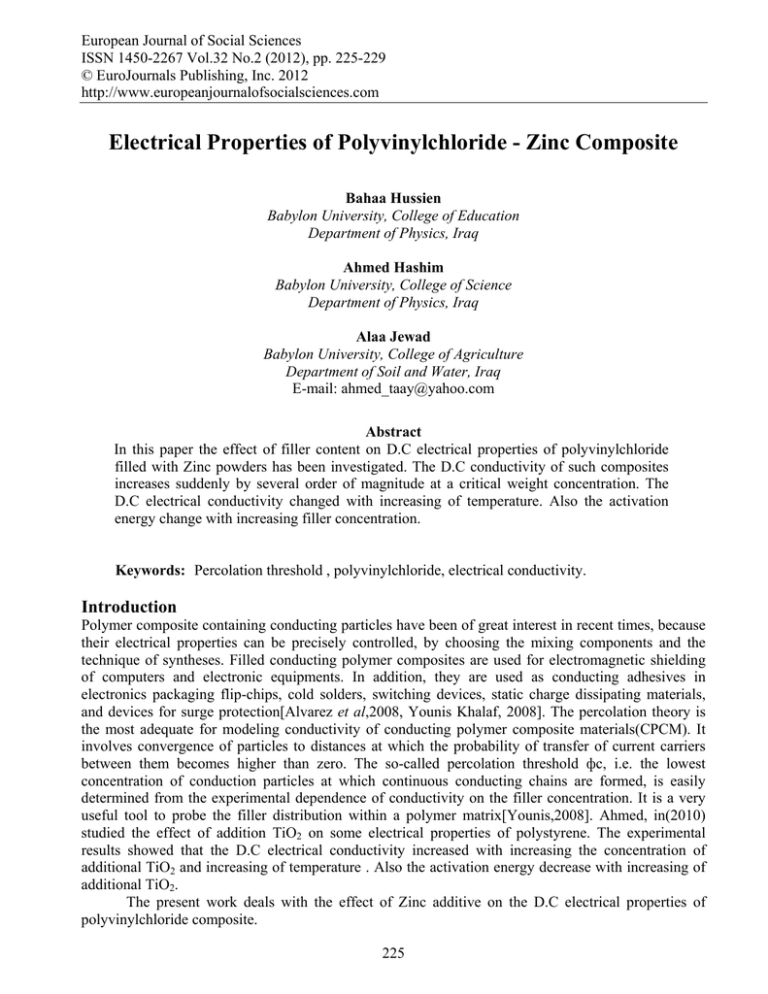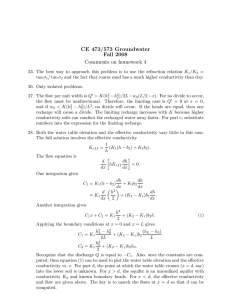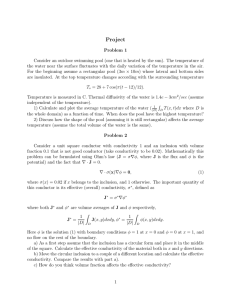European Journal of Social Sciences © EuroJournals Publishing, Inc. 2012
advertisement

European Journal of Social Sciences ISSN 1450-2267 Vol.32 No.2 (2012), pp. 225-229 © EuroJournals Publishing, Inc. 2012 http://www.europeanjournalofsocialsciences.com Electrical Properties of Polyvinylchloride - Zinc Composite Bahaa Hussien Babylon University, College of Education Department of Physics, Iraq Ahmed Hashim Babylon University, College of Science Department of Physics, Iraq Alaa Jewad Babylon University, College of Agriculture Department of Soil and Water, Iraq E-mail: ahmed_taay@yahoo.com Abstract In this paper the effect of filler content on D.C electrical properties of polyvinylchloride filled with Zinc powders has been investigated. The D.C conductivity of such composites increases suddenly by several order of magnitude at a critical weight concentration. The D.C electrical conductivity changed with increasing of temperature. Also the activation energy change with increasing filler concentration. Keywords: Percolation threshold , polyvinylchloride, electrical conductivity. Introduction Polymer composite containing conducting particles have been of great interest in recent times, because their electrical properties can be precisely controlled, by choosing the mixing components and the technique of syntheses. Filled conducting polymer composites are used for electromagnetic shielding of computers and electronic equipments. In addition, they are used as conducting adhesives in electronics packaging flip-chips, cold solders, switching devices, static charge dissipating materials, and devices for surge protection[Alvarez et al,2008, Younis Khalaf, 2008]. The percolation theory is the most adequate for modeling conductivity of conducting polymer composite materials(CPCM). It involves convergence of particles to distances at which the probability of transfer of current carriers between them becomes higher than zero. The so-called percolation threshold фc, i.e. the lowest concentration of conduction particles at which continuous conducting chains are formed, is easily determined from the experimental dependence of conductivity on the filler concentration. It is a very useful tool to probe the filler distribution within a polymer matrix[Younis,2008]. Ahmed, in(2010) studied the effect of addition TiO2 on some electrical properties of polystyrene. The experimental results showed that the D.C electrical conductivity increased with increasing the concentration of additional TiO2 and increasing of temperature . Also the activation energy decrease with increasing of additional TiO2. The present work deals with the effect of Zinc additive on the D.C electrical properties of polyvinylchloride composite. 225 European Journal of Social Sciences – Volume 32, Number 2 (2012) Experimental Work The materials used in the paper is polyvinylchloride as matrix and Zinc as a filler. The electronic balanced of accuracy 10-4 have been used to obtain a weight amount of Zinc powder and polymer powder .These mixed by Hand Lay up and the Microscopic Examination used to obtain homogenized mixture .The weight percentages of Zinc are ( 0, 20,40,50 and 55) wt.% The Hot Press method used to press the powder mixture. The mixture of different Zinc percentages has been compacted at temperature 175oC under a pressure 100 bar for 10 minutes . Its cooled to room temperature , the samples were disc shape of a diameter about 15mm and thickness ranged between (1.055-1.52)mm. The coating unit (Edward coating System E3C6A) has been used for deposition of thin film Aluminum electrode on both sides of each sample . The resistivity was measured over range of temperature from (30 to 80)oC using Keithly electrometer type (616C) .The volume electrical conductivity defined by : ν σ σ ν = 1 ρ = L RA (1) v Where : A = guard electrod effective area. R = volume resistance (Ohm) . L = average thickess of sample (cm) . In this model the electrodes have circular area A= D2π/4 where D= 0.5 cm2 . Results and Discussion The observed variation of electrical conductivity of PVC composites with increasing Zinc content is illustrated in figure(1).The general theory to explain the conduction mechanism of fibers or particlefilled polymer composites is the "theory of conductive paths"[ Farshidfar, 2006]. Figure 1: Variation of D.C electrical conductivity with Zn wt % concentration for (PVC-Zn) composite. Conductivity(S/cm) 1.E-01 1.E-03 1.E-05 1.E-07 1.E-09 1.E-11 1.E-13 1.E-15 0 10 20 30 40 50 60 Con. Zn w t.% Which suggests that is the existence of conductive paths that results in the conductivity of the composites, conductive paths among the fibers or particles increase, and the average distance between the fibers or particles becomes smaller; thus, the conductivity of the composites increases[Srivastava and Mehra, 2009]. When the content of the Zn is filled, a conductive network has been formed in the composites; then, increasing the content of Zn can only slightly increase the conductive paths as illustrated in the microscopic photographs in figure (2). 226 European Journal of Social Sciences – Volume 32, Number 2 (2012) Figure 2: Figure (2) Photomicrographs for PVC-Zn composite (a) for pure,(x50) . (b) for20 wt.% Zn ,(x50) (c) for 55wt.% Zn ,(x50) A B C Figure (3) shows the behavior of electrical volume conductivity of the samples with the temperature. Note that the electrical conductivity increases with increasing temperature for low concentration[ф<фc], and that any of these materials has a negative thermal coefficient of resistance. The interpretation of this fact is that the polymeric chains and Zinc particles act as traps of the charge carriers, which transit by hopping process. On increasing the temperature, segments of the polymer begin to move, releasing the trapped charges. The released of trapped charges is intimately associated with molecular motion. The increase of current with temperature is attributed to two main parameters, charge carriers and mobility of these charges. The increase of temperature will increase the number of charge carriers exponentially. The mobility depends on the structure and the temperature . For high concentration of Zinc note that the electrical conductivity decreases with increasing temperature because the composite becomes a good conductive substance [Al-Ramadhan, 2008; Majdi and Fadhal, 1997]. Figure 3: Variation of D.C. electrical conductivity with temperature for (PVC-Zn) composite Conductivity(S/cm) 1.E+00 pur e 20wt .% 1.E-02 40wt .% 50wt .% 1.E-04 55wt .% 1.E-06 1.E-08 1.E-10 1.E-12 1.E-14 300 310 320 330 340 350 T(K) Figure (4) shows the relationship between the ln(conductivity) and inverted absolute temperature of the PVC-Zinc composites, using equation σ = σo exp(-Ea/kBT) was calculate activation energy, the high activation energy values for neat sample and low Zinc concentration sample can be attributed to the thermal movement of the ions and molecules, whereas the low activation energy 227 European Journal of Social Sciences – Volume 32, Number 2 (2012) values for the samples of higher Zinc content can be attributed to the electronic conduction mechanism which is related to the decreasing of the distance between the Zinc particles . [Hamzah et.al ,2008] Figure 4: Variation of D.C. electrical conductivity with reciprocal absoure temperature for (PVC-Zn) composite 0 ln(conductivity) -5 pure 20wt .% -10 40wt .% 50wt .% -15 55wt .% -20 -25 -30 -35 2.9 3 3.1 3.2 3.3 3.4 1000/T(k)-1 The concentration increasing of Zinc less the result of the activation energy as shown in the figure (5) of PVC- Zn composites for (Φ<Φc)which is a reasonable support for the above discussion [Ahmed and Zihilif,1992]. Figure 5: Variation activiation energy for D.C. electrical conductivity with Zn wt% concentration for PVC-Zn composite (ø<øo) 0.6 0.55 E(eV) 0.5 0.45 0.4 0.35 0.3 0.25 0.2 0 5 10 15 20 25 30 35 40 Zn.con.wt.% Conclusions 1. The D.C electrical conductivity of the polyvinylchloride increases by increasing the Zinc concentrations and the temperature 2. The activation energy of D.C electrical conductivity decreases by increasing Zinc concentrations. References [1] Ahmed H., 2010, "Effect of addition TiO2 on some Electrical Properties of Polystyrene", Proceedings of the 17th Scientific Conference of College of Education / Al-Mustansirya University, may, Iraq. 228 European Journal of Social Sciences – Volume 32, Number 2 (2012) [2] [3] [4] [5] [6] [7] [8] [9] Al-Ramadhan. Z. , 2008,"Effect of Nickel salt on electrical properties of polymethylmethacrylate" , J. of college of education ,Al-Mustansiriyah Uni..No.3. Alvarez M. P. and Poblete V.H., 2008, " Submicron Copper- Low- Density polyethylene conducting composites : Structural, Electrical and percolation Threshold" ,Chile. Ahmed M. S. and Zihilif A. M. , 1992, " The electrical conductivity of polypropylene and Nickel- Coated carbon Fiber composite ",J. Mater. Sc. Vol. 25 , No. 706, Uni of Jordan , Amman , Jordan. Farshidfar A., Haddadiv. and Nazokdast H., 2006,"Electrical and Mechanical properties of conductive carbon black/polyolefin composites mixed with carbon fiber, composites convention and Trade show American composites Mamufactarers Association, St. Louis., Mo USA. Hamzah M. , Saion E., Kassim A. and Yousuf M. , 2008, "Temperature dependence of AC Electrical conductivity of PVA-PPy-FeCl3 composites polymer Films", MPJ. Vol. 3, No. 2 , p(24-31) , Malaysia. Majdi. K.s and Fadhal H .J,1997,"Electrical conduction of PMMA and the effect of Graphite addition" , Uni. Of Basrah, Iraqi of Polyms. , Vol.1, No. 1 , pp(15-20). Srivastava N. K. and Mehra R. M. , 2009," Study of electrical properties of polystyrene / foliated graphite composite " , J.Materials Science- Poland,Vol.27, No.1 Uni. Of Delhi South Campus Younis Khalaf, 2008, The dielectric properties of polyvinylchloride-nickel composites, J. of physics, No.3, P.(529-536). 229





